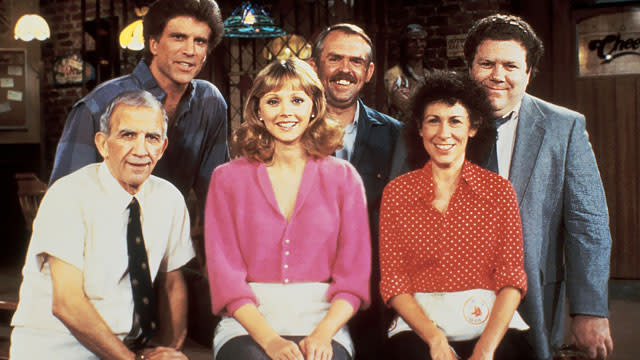'Cheers' 30th anniversary: What you never knew about the show

Let’s all raise a glass and give a toast to the gang at “Cheers,” who are celebrating their 30th anniversary this weekend. Diane Chambers first walked into Sam Malone’s Boston bar on September 30, 1982… and viewers couldn’t have cared less, actually. “Cheers” debuted dead-last in the ratings (77th out of 77 shows), but NBC stuck with it, and over an eleven-year run, it grew into the top-rated show on television -- and an all-time comedy classic.
The new issue of GQ has a fascinating oral history of the 1982-93 NBC series, with key cast members and producers sharing never-before-told stories. “Cheers” fans should definitely sit down and read the whole piece, but we’ve collected the best tidbits here, so pull up a barstool and find out what you never knew about the bar where everybody knows your name.
It was more than just acting ability that landed Shelley Long the role of Diane. She was up against a few other actresses, including “Newhart’s” Julia Duffy, for the part, but a near-wardrobe malfunction may have sparked some instant chemistry with future co-star Ted Danson (Sam). “Before the audition, I grabbed the dress I'd been planning to wear, only to realize that the waistband had been stretched to double its normal size,” Long recalls. “When I met Ted, I realized too late that it was so blousy that I was giving him quite the view. I think it got us off to a really great start.” Danson, for his part, remembers it differently: “I was too terrified to notice she had breasts.”
“Cheers” made its first of several smooth casting transitions in 1985 when a 24-year-old Woody Harrelson came in to play farm boy Woody Boyd, replacing beloved co-star Nicholas Colasanto (Coach), who had died of a heart attack. And the “young whippersnapper” impressed his male co-stars right away with his athletic prowess. “Offstage, it was [all] testosterone,” Danson says. “The guys used to play basketball right before the show. We took [Woody] out to give him a lesson, and he kicked our a--es. All right, we'll arm-wrestle. I still have, like, tendinitis in my elbow. He was just wiping the floor with me. Woody cleaned everybody's clock in everything. Then we got less physical and went to chess, and he whipped our a--es at chess.”
By contrast, Kelsey Grammer felt less than welcome when he joined the cast as pompous psychiatrist Frasier Crane. Frasier was brought in to be a wedge between Sam and Diane, but Long didn’t like the idea... at least that’s how Grammer remembers it. “Shelley's efforts to get me off the show were relentless,” Grammer wrote in his 1996 autobiography. “I learned after read-throughs she would insist the writers took out every laugh I had.” But Long disputes that entirely, and the two co-stars have since made peace. Grammer now says, “Who knows? Maybe it was all my problem! I don't know. Maybe none of that was really true.” (Hmmm… sounds like someone needs to sit down with a good therapist.)
Cracks started to show in the rest of the cast’s working relationship with Long during what would be her final season. “Cheers” director Thomas Lofaro remembers, “Shelley believed that she was the new Lucille Ball, and she would spend hours after the run-through talking with the writers about her character, just talking it to death.” To this day, co-star Rhea Perlman (Carla) doesn’t want to talk about what led to Long’s departure (“I don’t think it’s worth it, at this point in life”), but Danson admits, “I had trouble hanging around [Long] until we stood onstage together, and then I was in heaven.”
[Related: Happy Birthday, Shelley Long: The 'Cheers' Actress Turns 63]
“Cheers” was a bona fide hit when Long left in 1987, so the search to find her replacement wasn’t easy. To play hard-charging businesswoman Rebecca Howe, the producers loved Kirstie Alley, but the network didn’t think she could be funny. So to make the network happy, they brought in a pre-“Basic Instinct” Sharon Stone, Kim Cattrall (a decade before “Sex and the City”), and future “CSI” star Marg Helgenberger to audition. But they still insisted Alley was perfect for the role, and the network eventually gave in. Casting director Jeff Greenberg remembers, “NBC finally said, ‘Well, if they are that passionate about her, how can we deny [them]?’” And they were proven right: Ratings actually went up in Alley’s first “Cheers” season.
By the time Season 11 rolled around, Danson had had enough and announced he was leaving the show. “For a couple of years, we were all saying, ‘Are we going to do this forever?’ We were looking for an exit,” he says now. But Harrelson remembers that one unnamed network executive “took me to dinner and said, ‘We can keep the show going, and you'll be the guy who owns the bar.’ We hadn't even had our appetizers yet! I said, ‘Ted Danson's the star, and I can promise people will not want to see it without him.’ I didn't want to do it without him. Dinner was awkward after that.”
“Cheers” closed its doors for good in 1993, with 40 million viewers tuning in to watch the final episode. In the nearly twenty years since, there’s never been a “Cheers” reunion, but Alley’s open to it: “I think it would be great to have a reunion with everybody now, as long as it's just another stupid day at the bar: Rebecca's divorced, Sam's still not married. They're all in the exact same situation.” But producer Glen Charles says, “We never even considered doing any kind of reunion show. Sam alone at the bar was the last image we wanted. That's where the show started and where it ended.”
More from GQ:

